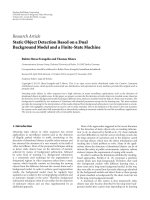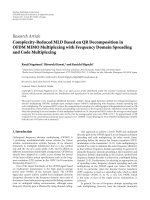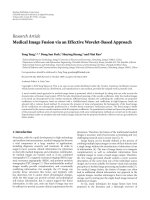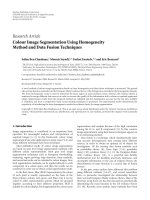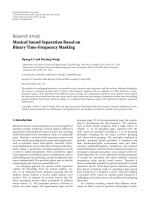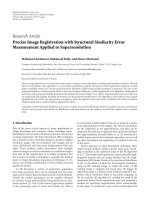Báo cáo hóa học: " Research Article Progressive Image Transmission Based on Joint Source-Channel Decoding Using Adaptive Sum-Product Algorithm" docx
Bạn đang xem bản rút gọn của tài liệu. Xem và tải ngay bản đầy đủ của tài liệu tại đây (938.17 KB, 9 trang )
Hindawi Publishing Corporation
EURASIP Journal on Image and Video Processing
Volume 2007, Article ID 69805, 9 pages
doi:10.1155/2007/69805
Research Article
Progressive Image Transmission Based on
Joint Source-Channel Decoding Using Adaptive
Sum-Product Algorithm
Weiliang Liu
1, 2
and David G. Daut
1
1
Depar tment of Electrical and Computer Engineering, Rutgers, The State University of New Jersey,
Piscataway, NJ 08854, USA
2
Qualcomm Inc., San Diego, CA 92121, USA
Received 13 August 2006; Revised 12 December 2006; Accepted 5 January 2007
Recommended by B
´
eatrice Pesquet-Popescu
A joint source-channel decoding method is designed to accelerate the iterative log-domain sum-product decoding procedure of
LDPC codes as well as to improve the reconstructed image quality. Error resilience modes are used in the JPEG2000 source codec
making it possible to provide useful source decoded information to the channel decoder. After each iteration, a tentative decoding
is made and the channel decoded bits are then sent to the JPEG2000 decoder. The positions of bits belonging to error-free coding
passes are then fed back to the channel decoder. The log-likelihood ratios (LLRs) of these bits are then modified by a weighting
factor for the next iteration. By observing the statistics of the decoding procedure, the weighting factor is designed as a function
of the channel condition. Results s how that the proposed joint decoding methods can greatly reduce the number of iterations,
and thereby reduce the decoding delay considerably. At the same time, this method always outperforms the nonsource controlled
decoding method by up to 3 dB in terms of PSNR.
Copyright © 2007 W. Liu and D. G. Daut. This is an op en access article distributed under the Creative Commons Attribution
License, which permits unrestricted use, distribution, and reproduction in any medium, provided the original work is properly
cited.
1. INTRODUCTION
Progressive coded images, such as those compressed by wa-
velet-based compression methods, have wide application in-
cluding image communications via band-limited wireless
channels. Due to the embedded struc tures of the correspond-
ing compressed codestreams, transmission of such images
over noisy channels exhibits severe error sensitivity and al-
ways experiences error propagation. Forward error correc-
tion (FEC) is a typical method used to ensure reliable trans-
mission. Powerful capacity-achieving channel codes such as
turbo codes and low-density parity-check (LDPC) codes
have been used to protect the JPEG2000 codestream using
various methods [1–3]. The typical idea of these schemes
is to assig n different channel protection levels via joint
source-channel coding (JSCC) based on a rate distortion
method. In addition to JSCC systems that are designed at
the transmitter/encoder side, researchers also find that joint
source-channel decoding (JSCD) can be achieved at the re-
ceiver/decoder side. T he concept of utilizing source decoded
information to aid the channel decoding procedure, and
hence, improve the overall performance of the receiver can be
tracedbacktoearlyworkbyHagenauer[4]. He proposed a
modification to the Viterbi decoding algorithm that used ad-
ditional apriorior a posteriori information about the source
bit probability. A generalized framework which is suitable
to any binary channel code was introduced in [5]. The it-
erative decoding procedure of turbo codes, implemented by
exchanging the extrinsic information from one constituent
decoder to another, makes it quite natural to use the infor-
mation that comes from the source decoder as an additional
extrinsic message, and thereby generate better soft-output
data during each iteration. The iterative decoding behavior
of the turbo codes can be found in [6, 7].TheJSCDmeth-
ods using turbo codes have been studied in [8–11]. Image
transmission based on turbo codes using a JSCD method
was studied in [12] where vector quantization, JPEG, and
MPEG coded images were tested and a wide range of im-
provements in turbo decoding computational efficiency was
shown. After the rediscovery of the low-density parity-check
2 EURASIP Journal on Image and Video Processing
(LDPC) codes [13, 14], they had been quickly adopted for
many applications including image transmission. LDPC iter-
ative decoding behavior has b een studied in [ 15–17]. In [18],
a JSCD method for JPEG2000 images has been proposed us-
ing a modification algorithm similar to that in [12].
In this paper, we develop a JSCD method for JPEG2000
image transmission on both AWGN and flat Rayleigh fading
channels. Fading channels wherein the receiver either has, or
does not have additional channel state information (CSI) are
considered. A regular LDPC code is used as the error cor-
recting code. Log-domain iterative sum-product algorithm
is chosen as the channel decoding method. After each iter-
ation of the log-domain sum-product algorithm, the source
decoder provides useful information as feedback that is based
on the error resilience modes employed in the source codec.
The information is then used to modify the log-likelihood ra-
tio (LLR) of the corresponding bit nodes. The new modifica-
tion factor presented in this paper extends the idea previously
investigated in [12, 18]. Results show that the new scheme
can accelerate the iterative sum-product decoding process as
well as improving the overall reconstructed image quality.
The outline of this paper is as follows. Section 2 presents
the sum-product algorithm and some observations about its
iterative behavior. JPEG2000 and its error resilience capa-
bility are first described in Section 3 followed by the design
of the joint source-channel decoding algorithm. Section 4
presents selected simulation results. Conclusions are given in
Section 5.
2. SUM-PRODUCT ALGORITHM AND
ITS ITERATIVE BEHAVIOR
The iterative sum-product algorithm for LDPC decoding in
the log-domain is first introduced in this section. Both the
AWGN channel and the flat Rayleigh fading channels with
and without CSI are considered. The corresponding behav-
iors of the iterative algorithm are described in the second part
of this section.
2.1. Log-domain sum-product algorithm
Consider an M
×N sparse parity check matrix H,whereM =
N −K. N is the length of a codeword, and K is the length of
the source information block. An example of H is shown as
H
=
⎡
⎢
⎢
⎢
⎢
⎢
⎣
1101101010
0110011011
0101110101
1010110110
1011001101
⎤
⎥
⎥
⎥
⎥
⎥
⎦
. (1)
ThesparsematrixH has an equivalent bipartite graph de-
scription called a Tanner graph [19]. Figure 1 shows the Tan-
ner graph corresponding to (1). In the graph, each column
(row) of H corresponds to a bit node (a check node). Edges
connecting check and bit nodes correspond to ones in H.In
this example, each bit node is connected by 3 edges and each
check node is connected by 6 edges. Therefore, each column
of H corresponds to a bit node with weight 3 and each row of
Check nodes
m1 m2 m3 m4 m5
n1
n2
n3 n4 n5
n6
n7
n8 n9
n10
r
x
mn
q
x
nm
Bit nodes
Figure 1: An example of Tanner graph corresponding to the matrix
H in (1).
H corresponds to a check node with weight 6. A detailed iter-
ative sum-product decoding algorithm is presented in [20].
In order to reduce the computation complexity and the nu-
merical instability, a log-domain algorithm is preferred. It is
introduced briefly as follows.
The message r
x,l
mn
, the probability that bit node n has
the value x given the information obtained via all the check
nodes connected to it other than check node m for the lth
iteration, is passed from check nodes to bit nodes. Simi-
larly, the dual message q
x,l
nm
is passed from bit nodes to check
nodes. Here, x is either 1 or 0. We define a set of bits n
that participate in check m as N (m)
={n : H
mn
= 1}
and define a set of checks m in which bit n participates as
M(n)
={m : H
mn
= 1}.NotationN (m) \ n denotes a set
N (m) with bit n excluded and notation M(n)
\ m denotes
asetM(n)withcheckm excluded. The algorithm produces
the LLR of the a posteriori probabilities for all the codeword
bits after a certain number of iterations.
Consider an AWGN channel with BPSK modulation that
maps the source bit c to the transmitted symbol x according
to x
= 1 − 2c. The received signal is modeled as y = x + n
w
with the conditional distribution
p(y
| x) =
1
√
2πσ
2
exp
−
(y − x)
2
2σ
2
,(2)
where n
w
is white Gaussian noise with variance σ
2
= 1/2 ·R ·
(E
b
/N
0
), and R is the channel code rate. At the initial step, bit
nodes n have the values given by
Lc
n
= Lq
0
nm
= log
P
c
n
= 0 | y
n
P
c
n
= 1 | y
n
=
2
σ
2
· y
n
. (3)
Denote the corresponding LLR of the messages q
x,l
nm
and r
x,l
mn
as Lq
l
nm
= log(q
0,l
nm
/q
1,l
nm
)andLr
l
mn
= log(r
0,l
mn
/r
1,l
mn
), respec-
tively. Before the first iteration, Lq
0
nm
is set to Lc
n
.Byde-
noting Lq
l
nm
= α
l
nm
· β
l
nm
,whereα
l
nm
= sign(Lq
l
nm
)and
β
l
nm
= abs(Lq
l
nm
), the first and the second parts of one it-
eration are
Lr
l
mn
=
n
∈N (m)\n
α
l
n
m
·
Φ
n
∈N (m)\n
Φ
β
l
n
m
,(4)
Lq
l
nm
= Lc
n
+
m
∈M(n)\m
Lr
l
m
n
,(5)
W. Liu and D. G. Daut 3
where Φ(x) =−log(tanh(x/2)) = log((e
x
+1)/(e
x
− 1)).
The LLR of “pseudoposteriori probability” defined as LQ
l
n
=
log(Q
0,l
n
/Q
1,l
n
) is then computed as
LQ
l
n
= Lc
n
+
m∈M(n)
Lr
l
mn
. (6)
The following tentative decoding is made:
c
l
n
= 0(or1)if
LQ
l
n
> 0(or< 0). When LQ
l
n
= 0, c
l
n
is set to 0 or 1 with equal
probability. In theory, when H
c
l
n
= 0, the iterative procedure
stops.
2.2. Decoding in the case of fading channels
For wireless communication, Rayleigh fading channel is typ-
ically a good channel model. Consider an uncorrelated flat
Rayleigh fading channel. Assume that the receiver can esti-
mate the phase with sufficient accuracy, then coherent de-
tection is feasible. The received signal is now modeled as
y
= ax + n
w
,wheren
w
is white Gaussian noise as described
in the previous subsection. The parameter a is a normal-
ized Rayleigh random variable with distribution P
A
(a) =
2a · exp(−a
2
)andE[a
2
] = 1. Assume that the fading coef-
ficients are uncorrelated for different symbols. BPSK mod-
ulation maps the source bit c to the transmitted symbol x
according to x
= 1 − 2c. At the initial step, the bit nodes n
take on the values
Lc
n
= log
P
c
n
= 0 | y
n
P
c
n
= 1 | y
n
=
2a
σ
2
· y
n
. (7)
The message definition above implies that the receiver has
perfect knowledge of the CSI. For the case when CSI is not
available at the receiver, E[a]
= 0.8862 can be used instead of
the instantaneous value a in (3). Thus, the bit nodes n take
on the values
Lc
n
= log
P
c
n
= 0 | y
n
P
c
n
= 1 | y
n
=
2E[a]
σ
2
· y
n
. (8)
For each iteration thereafter, the relationships given in (4)–
(6) are used once again without any changes.
2.3. Behavior of the sum-product algorithm
As mentioned above, once H
c
n
= 0, the iterative procedure
stops. However, a large number of iterations may be needed
to meet this criteria. Also, there is no guarantee that the it-
erative procedure converges unless the codeword length is
infinite. In real-world applications, there exist three imple-
mentation problems: (1) finite block lengths (e.g., 10
3
–10
4
)
are used; (2) the sum-product algorithm is optimal in the
sense of minimizing the bit error probability for a cycle-free
Tanner graph. For finite length codes, the influence of cycles
cannot be neglected; and (3) the maximum number of itera-
tions is always preselected before communication takes place.
The preselected iteration number is usually smaller (e.g., 40–
60) compared to the number that is needed to satisfy the
strict stopping criteria. Examples are presented in the follow-
ing to illustrate the iterative behavior of LDPC codes. A reg-
ular (4096,3072) LDPC code with rate 3/4 is selected. The
0 1020 3040506070
0
100
200
300
0 1020 3040506070
0
100
200
300
0 1020 3040506070
0
100
200
300
0 1020 3040506070
0
100
200
300
0 1020 3040506070
0
100
200
300
0 1020 3040506070
0
100
200
300
Number of iterations
Histograms
Figure 2: Histogram for number of iterations for the log-domain
sum-product algorithm over AWGN channel. (γ
= 2.50 to 3 dB in
increments of 0.1 dB, from top to bottom.)
log-domain decoding procedure is performed for a total of
1000 transmission trials. The maximum number of channel
decoder iterations is set to 60 for each trial. Two channels
are tested, one is the AWGN channel and the other is the
flat fading channel with CSI. Figures 2 and 3 show the his-
tograms of the iteration numbers versus γ
= E
b
/N
0
and the
average E
b
/N
0
, γ.Thex-axis represents the number of itera-
tions needed for each LDPC decoding trial. The y-axis repre-
sents the number of occurrences (out of 1000 experiments)
of a certain number of iterations. The figures illustrate that
with increasing γ and
γ, the overall histogram becomes more
and more narrow. This means that the decoding time reduces
when better channel conditions are realized. Another point
of observation obtained from these figures is that of the bars
located at the maximum number of iterations, 60. For an
AWGN channel, operating at γ
= 2.5 dB, there are about 100
out of 1000 times that the decoding procedure does not sat-
isfy H
c
n
= 0, and has to abruptly stop. With increased chan-
nel SNR, this number becomes 31, 12, and 2 at γ
= 2.6, 2.7,
and 2.8 dB, respectively. The number of times the maximum
is needed becomes zero as the channel condition continues
to improve. Similar observations are also found for the fad-
ing channel. In Figure 3, operating at
γ = 6.55 dB, there are
about 36 decoding procedures that do not satisfy H
c
n
= 0
and have to stop. This number becomes 6 at
γ = 6.75 dB.
Reducing the number of decoding failures indicates that the
performance of the code becomes increasingly better.
In addition to the histogram of iteration numbers, Fig-
ures 4 and 5 present two meaningful statistics, the mean
and the median of the number of iterations, for the AWGN
channel and the fading channels with and without CSI. It is
shown that the mean number of iterations is a monotonically
decreasing function of the channel conditions. The discrete
4 EURASIP Journal on Image and Video Processing
0 10203040506070
0
100
200
0 10203040506070
0
100
200
0 10203040506070
0
100
200
0 10203040506070
0
100
200
0 10203040506070
0
100
200
Number of iterations
Histograms
Figure 3: Histogram for number of iterations for the log-domain
sum-product algorithm over flat fading channel with CSI. (
γ = 6.55
to 6.75 dB in increments of 0.05 dB, from top to bottom.)
4
6
8
10
12
14
16
18
20
22
2.52.62.72.82.933.13.23.33.43.5
E
b
/N
0
(dB)
Number of iterations
Mean
Median
Figure 4: Mean and median number of iterations over AWGN
channel.
values of the median have a property similar to a nonincreas-
ing function. The mean and median are two important statis-
tics that better measure the number of iterations needed dur-
ing the decoding process.
The decoder iteration behaviors described above provide
some insight for practical design considerations. It is desired
to establish a JSCD methodology that has the capability to
update the messages that are passing back and forth between
the bit and check nodes during the iterations. Furthermore,
such updated information should come from outside of the
10
12
14
16
18
20
6.46.66.877.27.47.67.88
Average E
b
/N
0
(dB)
Number of iterations
Mean CSI
Median CSI
Mean no CSI
Median no CSI
Figure 5: Mean and median number of iterations over flat Rayleigh
fading channel with and without CSI.
LDPC decoder as extrinsic information similar to that which
is exchanged between the constituent convolutional decoders
within an iterative turbo decoder.
3. JOINT SOURCE-CHANNEL DECODER DESIGN
A natural choice for the provider of the extrinsic informa-
tion is the source decoder that follows the channel decoder.
In this paper, the JPEG2000 decoder after the LDPC decoder
can provide such extrinsic information. The error resilience
tools provided in the JPEG2000 standard are discussed in the
first part of this section. In the second part, the details of the
JSCD design are provided.
3.1. Error resilience methods in JPEG2000
In the JPEG2000 standard, several error resilience methods
are defined to deal with the error sensitivity and error prop-
agation resulting from its embedded codestream struc ture.
Among them, a combined use of “RESTART” and “ERT-
ERM” tools provides a mechanism such that if there exists
at least one bit error in any given coding pass, the remaining
coding passes in the same codeblock will be discarded since
the rest of bits in this codeblock have strong dependency on
the error bit. The mechanism is illustrated in Figure 6. In this
example, a codeblock in the LH subband of the second res-
olution (corresponding to the second packet in each qual-
ity layer) has 15 coding passes. They are distributed into 3
quality layers. After transmission, assume that a bit error oc-
curred at the 10th coding pass. Thus, the JPEG2000 decoder
will only use the first 9 error-free coding passes of this code-
block for reconstruction. Since the last 6 coding passes are
discarded, errors are thereby limited to only one codeblock
W. Liu and D. G. Daut 5
Packet
1
Packet
2
Packet
6
Packet
7
Packet
8
Packet
12
Packet
13
Packet
14
Packet
18
Layer 1 Layer 2 Layer 3
HL LH HH HL LH HH HL LH HH
9 useful coding passes w ill be updated 6 coding passes will stay unchanged
EX XXXX
Figure 6: Error resilience mechanism used in JPEG2000 to prevent error propagation.
and will not be propagated to other codeblocks in the trans-
mitted data stream.
3.2. Adaptive modification in the joint design
From the channel decoder point of view, the error resilience
mechanism implemented in the source decoder may provide
potential feedback information that makes it possible to de-
sign a joint source-channel decoder. In [12, 18], two differ-
ent modification methods have been proposed. The former
one either enlarges or reduces the extrinsic information in
turbo codes by the mappings x
= x · t or x
= x/t,re-
spectively, where t is the modification factor whose value de-
pends on the channel conditions. The latter one uses a simple
plus or minus operation to modify the LLR values in LDPC
codes as x
= x + t or x
= x − t.Wenotehere,most
importantly, that t is channel-independent. As discussed in
Section 2, the behavior of the iterative decoding algorithm is
channel-dependent. Hence, a channel-adaptive modification
algorithm is expected to be more beneficial both in the re-
duction of computation time and the improvement in over-
all image quality. Since the log-domain is used in the sum-
product algorithm, using plus and minus operations to in-
crease and decrease the LLR values coincides with the prod-
uct and division algorithms in the probability domain.
The proposed joint decoder block diagram is illustrated
in Figure 7. It operates as follows: the parts in the dashed line
frame represent a typical log-domain iterative sum-product
LDPC decoder. After the ith iteration, the JPEG2000 decoder
receives the tentative decoded bits
c
i
n
. Only several initial
JPEG2000 decoding steps wil l be executed. The aim is to find
which coding pass contains the first bit error within a code-
block. The whole JPEG2000 decoding procedure will not
be applied at this time. Compared to an iteration of LDPC
decoding, such an operation is very quick. In the example
shown in Figure 6, the 10th coding pass contained the first bit
error. The JPEG2000 decoder then feeds the positions of bits
P
i
, which belong to the useful coding passes (the first 9 useful
coding passes in Figure 6), back to the channel decoder. The
Lc
n
values corresponding to those positions will be updated
and denoted as Lc
i,new
n
. At the same time, the LLR values of
the last 6 coding passes will remain unchanged. The adaptive
Iterative LDPC decoder
Check nodes
Bit nodes
From
channel
Tent ati ve
decoding/
decision
Adaptive
modification
JPEG2000
decoder
Lq
i
nm
LQ
i
n
Lc
n
Lr
i
mn
Lc
i,new
n
P
i
c
i
n
I
i
Figure 7: Block diagram of the joint source-channel decoder.
modification methods will be discussed later. At the initial
step, Lc
n
is calculated using (3), (7), or (8), and after that,
for each iteration, it will be updated as Lc
i,new
n
and sent to the
bit nodes. Bit nodes then use Lc
i,new
n
to compute the second
part of the iteration corresponding to (5) and the tentative
decision. When the iterative procedure stops, the JPEG2000
decoder reconstructs the entire image I
i
as the system output.
Thus, the modification factor t(
·) used in the algorithm is de-
signed so as to be a function of the channel condition. Hence,
the desired parameter is t(γ), with γ being the channel SNR
in terms of E
b
/N
0
. A similar approach can be used in con-
nection with flat fading channels. Using the average channel
SNR,
γ, t(·) is designed to be t(γ, a)andt(γ, E[a]) for fading
channels with CSI and without CSI, respectively. Then, the
modification algorithm after each iteration is defined as
Lc
i,new
n
=
⎧
⎪
⎪
⎪
⎨
⎪
⎪
⎪
⎩
Lc
i−1,new
n
+ t(·)ifc
i−1
n
= 0; n ∈ P
i−1
,
Lc
i−1,new
n
− t(·)ifc
i−1
n
= 1; n ∈ P
i−1
,
Lc
i−1,new
n
if n/∈ P
i−1
,
(9)
where
t(
·) =
⎧
⎪
⎪
⎨
⎪
⎪
⎩
t(γ) for AWGN Channel,
t(
γ, a) for flat fading channel with CSI,
t
γ, E[a]
for flat fading channel without CSI.
(10)
6 EURASIP Journal on Image and Video Processing
At the initial iteration, Lc
0,new
n
= Lc
n
. P
i
is a set of bits that
belongs to the correct coding passes for the ith iteration ob-
tained from the JPEG2000 decoder. The Lc
i−1,new
n
values asso-
ciated with the P
i
bits are either plus or minus a modification
factor t(
·)soastogeneratenewLLRvalues.Bitsthatarenot
in the set P
i
hold onto their last iteration values without any
update. Further, since the fading coefficient a attenuates the
transmitted symbol x, it is worthwhile to compensate for a
in the case of those bits that belong to P
i
. Thus, the modifi-
cation factors can be written as t(
γ) /a and t(γ)/E[a], respec-
tively. B oth t(γ)andt(
γ) can be tabulated empirically before
beginning real-time tra nsmission of compressed image data.
4. SELECTED SIMULATION RESULTS
The proposed JSCD method and the associated modification
algorithm have been simulated. The 8-bit gray-scale Lena im-
age was used. Three source coding rates 1.0, 0.5, and 0.1 bpp
were selected. For each rate, three quality layers were gener-
ated. A (4096, 3072) regular LDPC code with rate 3/4 was
employed in the system. The maximum number of iterations
was set to 60. For AWGN and flat fading channels (assume
uncorrelated Rayleigh fading), different sets of γ or
γ were se-
lected so that the performances of the LDPC code are close to
each other under these channel conditions for different chan-
nel models. For each channel condition, the corresponding
BER performance is presented in Table 1.
For a source coding rate of 0.5 bpp, Tables 2–4 present
the simulation results for the AWGN channel and flat fad-
ing channels with and without CSI. In each table, the second
column shows the values of t(γ)andt(
γ). The quantity t(γ)
is divided by either a or E[a] for channels with or without
CSI to form the modification factors, respectively. The last
two columns show the PSNR (dB) and mean number of iter-
ations in pairs corresponding to without/with use of a joint
decoding strategy.
Data in the three tables are plotted in Figures 8 and 9.
Figure 8 illustrates the mean number of iterations for sys-
tems employing a JSCD design as well as for systems not
using a joint decoding design. It is obvious that for all the
channel models, the JSCD system requires less decoder it-
eration, which means that the overall decoding time can be
reduced. For an AWGN channel, the decoding time can be
reduced by as much as 2.16% to 16.93%. The decoding time
is reduced by 2.43% to 15.42% for the fading channel case.
Figure 9 shows the qualities of the reconstructed images both
with a JSCD design and without a joint decoding design em-
ployed at the receiver. In all the channel models, the PSNR
gain becomes smaller with an increase in the channel SNR.
Also, Figure 9 shows that the JSCD method is more effective
for the fading channel with CSI than that for the fading chan-
nel without CSI. That is due to the fact that E[a]isnotasuf-
ficient statistic compared to the instantaneous fading coeffi-
cient a. It has been found that a gain of 1.24 dB to 3.04 dB can
be obtained on an AWGN channel employing a JSCD design
for image transmission, while for a fading channel, the gain
in PSNR is up to 2.52 dB when CSI is available. Simulation
results illustrating the PSNR gain for the other two source
11
12
13
14
15
16
17
18
19
20
21
2.52.55 2.62.65 2.7
Channel SNR (dB)
Mean of number of iterations
No JSCD
JSCD
(a)
11.5
12
12.5
13
13.5
14
14.5
15
15.5
16
16.5
17
6.55 6.75 6.95 7.15 7.35 7.55 7.75
Channel SNR (dB)
Mean of number of iterations
No JSCD wtih CSI
JSCD with CSI
No JSCD w/o CSI
JSCD w/o CSI
(b)
Figure 8: Mean number of iterations with and without using a
JSCD design. Source coding rate at 0.5 bpp (a) for AWGN channel,
(b) for flat fading channels with and without CSI.
coding rates 0.1 bpp and 1.0 bpp are presented in Figures 10
and 11. The results are similar to the case of 0.5 bpp.
5. CONCLUSION
In this paper, we proposed a joint source-channel decoding
method for transmitting a JPEG2000 codestream. The iter-
ative log-domain sum-product LDPC decoding algorithm is
W. Liu and D. G. Daut 7
Table 1: Channel SNR sets and the corresponding BER performance.
AWGN 2.50 2.55 2.60 2.65 2.70
BER
2.4 ×10
−3
1.26 ×10
−3
5.90 ×10
−4
2.37 ×10
−4
1.90 ×10
−4
Fading CSI 6.55 6.60 6.65 6.70 6.75
BER
1.03 ×10
−3
7.94 ×10
−4
5.03 ×10
−4
2.71 ×10
−4
1.89 ×10
−4
Fading no CSI 7.60 7.65 7.70 7.75 7.80
BER
1.22 ×10
−3
7.87 ×10
−4
4.78 ×10
−4
3.10 ×10
−4
2.19 ×10
−4
16
17
18
19
20
21
22
23
24
25
26
27
28
29
2.52.55 2.62.65 2.7
Channel SNR (dB)
PSNR (dB)
No JSCD
JSCD
(a)
18
19
20
21
22
23
24
25
26
27
28
29
6.55 6.75 6.95 7.15 7.35 7.55 7.75
Channel SNR (dB)
PSNR (dB)
No JSCD wtih CSI
JSCD with CSI
No JSCD w/o CSI
JSCD w/o CSI
(b)
Figure 9: PSNR with and without using a JSCD design. Source cod-
ing rate at 0.5 bpp (a) for AWGN channel, (b) for flat fading chan-
nels with and without CSI.
16
17
18
19
20
21
22
23
24
25
26
27
28
29
2.52.55 2.62.65 2.7
Channel SNR (db)
PSNR (db)
NO JSCD
JSCD
(a)
18
19
20
21
22
23
24
25
26
27
28
29
6.55 6.75 6.95 7.15 7.35 7.55 7.75
Channel SNR (dB)
PSNR (dB)
No JSCD wtih CSI
JSCD with CSI
No JSCD w/o CSI
JSCD w/o CSI
(b)
Figure 10: PSNR with and without using a JSCD design. Source
coding rate at 0.1 bpp (a) for AWGN channel, (b) for flat fading
channels with and without CSI.
8 EURASIP Journal on Image and Video Processing
16
17
18
19
20
21
22
23
24
25
26
27
28
29
2.52.55 2.62.65 2.7
Channel SNR (dB)
PSNR (dB)
No JSCD
JSCD
(a)
18
19
20
21
22
23
24
25
26
27
28
29
6.55 6.75 6.95 7.15 7.35 7.55 7.75
Channel SNR (dB)
PSNR (dB)
No JSCD wtih CSI
JSCD with CSI
No JSCD w/o CSI
JSCD w/o CSI
(b)
Figure 11: PSNR with and without using a JSCD design. Source
coding rate at 1 bpp (a) for AWGN channel, (b) for flat fading chan-
nels with and without CSI.
used on both the AWGN and the flat fading channels. The
correct coding passes are fed back to update the LLR val-
ues after each iteration. The modification factor is chosen
to be channel-dependent. Thus, the feedback system adapts
to channel variations. Results show that at lower SNR for
all the channel models, the proposed method can improve
the reconstructed image by approximately 2 to 3 dB in terms
of PSNR. Also, the results demonstrate that the joint design
method reduces the average number of iterations by up to 3,
thereby considerably reducing the decoding time.
Table 2: Joint decoding results for AWGN channel.
γ t(γ) PSNR Mean
2.50 816.93/19.97/3.04 10.68/17.32/16.25%
2.55
819.36/22.03/2.67 17.71/15.33/13.44%
2.60
622.44/24.47/2.03 14.84/13.71/7.61%
2.65
525.59/27.35/1.76 13.40/12.98/3.13%
2.70
527.10/28.34/1.24 12.04/11.78/2.16%
Table 3: Joint decoding results for flat fading channel with CSI.
γ t(γ) PSNR Mean
6.55 720.21/22.73/2.52 16.73/14.15/15.42%
6.60
720.95/23.06/2.11 15.49/13.89/10.33%
6.65
622.61/24.45/1.84 14.64/13.27/9.36%
6.70
525.07/26.59/1.52 13.27/12.38/6.17%
6.75
426.62/27.56/0.94 12.35/11.93/3.40%
Table 4: Joint decoding results for flat fading channel without CSI.
γ t(γ) PSNR Mean
7.60 719.69/22.02/2.33 16.31/14.34/12.10%
7.65
720.51/22.48/1.97 15.33/13.77/10.18%
7.70
623.11/24.87/1.76 13.90/13.01/6.40%
7.75
524.55/25.89/1.34 13.27/12.65/4.67%
7.80
426.06/26.88/0.82 12.33/12.03/2.43%
REFERENCES
[1] B. A. Banister, B. Belzer, and T. R. Fischer, “Robust im-
age transmission using JPEG2000 and turbo-codes,” in Pro-
ceedings of the International Conference on Image Process-
ing (ICIP ’00), vol. 1, pp. 375–378, Vancouver, BC, Canada,
September 2000.
[2] Z. Wu, A. Bilgin, and M. W. Marcellin, “An efficient joint
source-channel rate allocation scheme for JPEG2000 code-
streams,” in Proceedings of Data Compression Conference
(DCC ’03), pp. 113–122, Snowbird, Utah, USA, March 2003.
[3] W. Liu and D. G. Daut, “An adaptive UEP transmission system
for JPEG2000 codestream using RCPT codes,” in Proceedings of
38th Asilomar Conference on Signals, Systems and Computers,
vol. 2, pp. 2265–2269, Pacific Grove, Calif, USA, November
2004.
[4] J. Hagenauer, “Source-controlled channel decoding,” IEEE
Transactions on Communications, vol. 43, no. 9, pp. 2449–
2457, 1995.
[5] N. G
¨
ortz, “A generalized framework for iterative source-
channel decoding,” in Turbo Codes, Error-Correcting Codes of
Widening Application,M.J
´
ez
´
equel and R. Pyndiah, Eds., pp.
105–126, Kogan Pade Science, Sterling, Va, USA, 2003.
[6] S. T. Brink, “Convergence of iterative decoding,” Electronics
Letters, vol. 35, no. 10, pp. 806–808, 1999.
[7] S. T. Brink, “Convergence behavior of iteratively decoded par-
allel concatenated c odes,” IEEE Transactions on Communica-
tions, vol. 49, no. 10, pp. 1727–1737, 2001.
W. Liu and D. G. Daut 9
[8] T. Hindelang, T. Fingscheidt, N. Seshadri, and R. V. Cox,
“Combined source/channel (de-)coding: can a priori infor-
mation be used twice?” in Proceedings of IEEE International
Symposium on Information Theory, p. 266, Sorrento, Italy, June
2000.
[9] M. Adrat, P. Vary, and J. Spittka, “Iterative source-channel de-
coder using extrinsic information from softbit-source decod-
ing,” in Proceedings of IEEE International Conference on Acous-
tics, Speech and Signal Processing (ICASSP ’01), vol. 4, pp.
2653–2656, Salt Lake, Utah, USA, May 2001.
[10] K. Lakovi
´
c and J. Villasenor, “On reversible variable length
codes with tur bo codes, and iterative source-channel decod-
ing,” in Proceedings of IEEE International Symposium on Infor-
mation Theory, p. 170, Lausanne, Switzerland, June-July 2002.
[11] M. Adrat, U. von Agris, and P. Vary, “Convergence behavior
of iterative source-channel decoding,” in Proceedings of IEEE
International Conference on Acoustics, Speech and Signal Pro-
cessing (ICASSP ’03), vol. 4, pp. 269–272, Hong Kong, April
2003.
[12] Z.Peng,Y F.Huang,andD.J.CostelloJr.,“Turbocodesfor
image transmission—a joint channel and source decoding ap-
proach,” IEEE Journal on Selected Areas in Communications,
vol. 18, no. 6, pp. 868–879, 2000.
[13] R. G. Gallager, “Low-density parity-check codes,” IRE Trans-
actions on Information Theory, vol. 8, no. 1, pp. 21–28, 1962.
[14] D. J. C. MacKay, “Good error-correcting codes based on very
sparse matrices,” IEEE Transactions on Information Theory,
vol. 45, no. 2, pp. 399–431, 1999.
[15] G. Lechner and J. Sayir, “On the convergence of log-likelihood
values in iterative decoding,” in Proceedings of Mini-Workshop
on Topics in Information Theory, pp. 1–4, Essen, Germany,
September 2002.
[16] G. Lechner, “Convergence of sum-product algorithm for finite
length low-density parity-check codes,” in Proceedings of Win-
ter School on Coding and Information Theory,MonteVerita,
Switzerland, February 2003.
[17] M. Ardakani, T. H. Chan, and F. R. Kschischang, “EXIT-chart
properties of the highest-rate LDPC code with desired conver-
gence behavior,” IEEE Communications Letters, vol. 9, no. 1,
pp. 52–54, 2005.
[18] L. Pu, Z. Wu, A. Bilgin, M. W. Marcellin, and B. Vasic, “Itera-
tive joint source/channel decoding for JPEG2000,” in Proceed-
ings of the 37th Asilomar Conference on Signals, Systems and
Computers, vol. 2, pp. 1961–1965, Pacific Grove, Calif, USA,
November 2003.
[19] R. M. Tanner, “A recursive approach to low complexity codes,”
IEEE Transactions on Information Theory,vol.27,no.5,pp.
533–547, 1981.
[20] D. J. C. MacKay and R. M. Neal, “Good codes based on very
sparse matrices,” in Cryptography and Coding: 5th IMA Con-
ference, C. Boyd, Ed., Lecture Notes in Computer Science, no.
1025, pp. 100–111, Springer, Berlin, Germany, 1995.

